769
"Smart" appliances: how does it work?

Technology "smart" house - one of the fastest growing global Internet market segments of things (IoT): is read the reports on the new industrialization and prospects "Industry 4.0" under the influence of a growing number of connected devices in the homes there is its "kitchen" revolution.
The range of equipment, which can be equipped with "smart" home, is very large: tens units of temperature sensors and energy-saving LED-lighting to intelligent home appliances and robots. About 220 million households worldwide will generate demand for technology for "smart" farming by 2019: at Strategy Analytics forecasts the number is increasing by 20% annually. The main catalyst - the widespread penetration of broadband Internet services, which are connected and "smart" devices (also called "plug»)
. art market for smart homes has at the moment a huge potential, and as the largest consumer electronics manufacturers and startups have already launched their visionary projects for the production of such products. According Markets & amp; Markets, technologies for the smart home market could grow to $ 46, 97 billion in 2015 to $ 121, 73 billion by 2022. A projected Future Market Insights (FMI) by 2015, the global consumer electronics market will grow by an average of 15, 4% in 2015-2020 and reach $ 2976, 1 billion, but the segment of smart devices will increase in volume is much faster - at 23% annually over the same period. All this means that our appliances will "get smarter" in front of us.
From iron to kettle
While the market is "smart" household appliances is quite young and most widespread penetration of such devices are in developed countries. For example, according to the US Consumer Electronics Association, in the United States every fifth homeowner who has connected high speed internet access, will buy at least one "smart" appliance for a year (since October 2015), so that the sale of such devices only the United States will grow from 20, 7 million pieces of equipment in 2014 to 35, 9 million by the end of 2016. Interestingly, more than half of these potential buyers - under the age of 35 years
. In other countries, the demand for "smart" technique will depend on the level of penetration of broadband Internet, by purchasing power (often "smart" appliances more expensive than equivalent devices that do not have the intellect) and other factors. According to the GfK study, conducted in the markets of developed countries in 7, 91% of respondents are aware of this kind of technology, 51% believe that the use of such technologies can significantly change the quality of their lives.
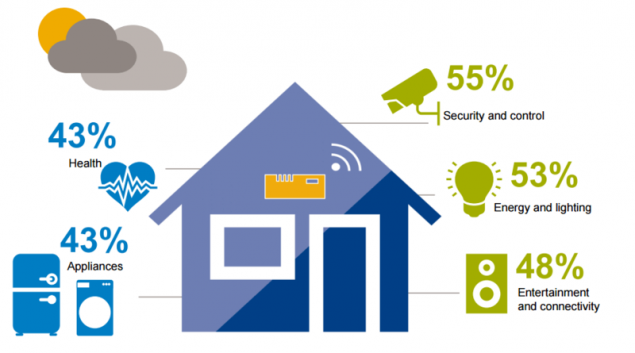
The most common smart appliances, according to the GfK, applied to the security and control of home ownership (55%), energy management and lighting (53%), for entertainment purposes (48%) and in 43% of cases - as part of the health care services, or simply to some service functions (cleaning, washing, cooking).
Relevant services can provide a variety of companies: utilities, electronics manufacturers, telecom operators, retailers, online shops, private and public health organizations. For example, services home video surveillance and access control systems often offer network operators with telephony, Internet access and pay-TV. Suppliers of electricity or other utility resources in Asia and the West offer a home equipped with "smart" appliances, encouraging users to careful handling. In fact, the use of such models there are so many, and often leads to the fact that in one house and grounds may not be a "zoo" of devices that supports a variety of services from different companies. This is why GfK polled 45% of respondents said they would prefer to receive a full range of services from a single source.
The pioneers and masters
In fact, vendors are well aware that the future of home IoT just for those companies that will be able to create a single service platform: on its basis will be able to operate all the devices of a single "smart" home, or at least most of them. Their most consistent development in this area sell five companies: Google, Apple, Quiky, Samsung and Xiaomi
. The first three companies have a "registration" in the United States and joined the race in the area of IoT about 2014. So, I start the Google consistently buy appropriate startups: home security systems manufacturer Dropcam, then Revolv and most famous of them - Nest - $ 3, 2 billion In addition, the Internet giant is working on a communication standard for "smart» Thread houses.. Apple's, by contrast, is not buying startups, and prefer to use their own development. Apple HomeKit platform allows you to manage different video unit with smartphones, the company also cooperates with the final decision makers, such as Elgato and iDevices. With regard Quiky, then the company is not very well known outside the United States, but in this country it has successfully promoted a joint platform Wink, along with General Electric.
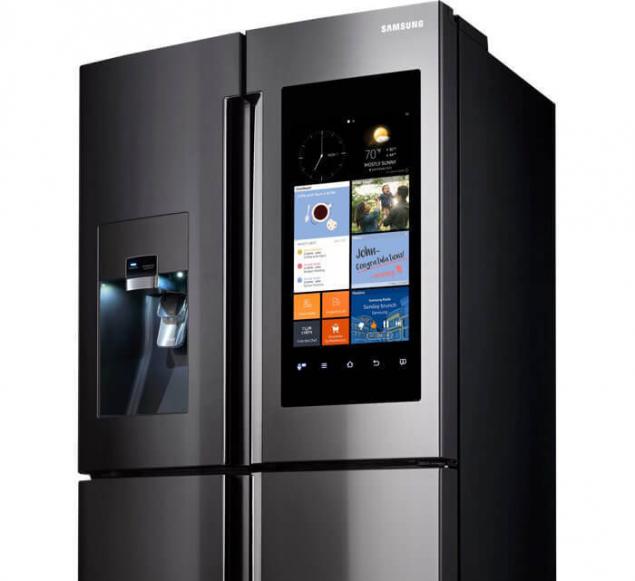
Samsung «smart" obsessed with the idea to make at home. Introduced in 2016 in the sale of smart refrigerator Samsung Family Hub with a huge touchscreen display I made a lot of noise in the market. The cost of the device - about $ 6,000.
Samsung and Xiaomi - Asian players. Korean Samsung is promoting a broad product portfolio of "smart" devices, from televisions to kitchen equipment, as well as buying promising startups IoT-: in 2014, for example, bought SmartThings. Watching the activities of Samsung, it is impossible not to note that it is literally "possessed" the idea of intellectualization. Thus, the company now confident that by 2020 they will be equipped with "smart" features any kind of household appliances. The vendor is also promoting its platform SmartHome on the basis of its own Tizen operating system.
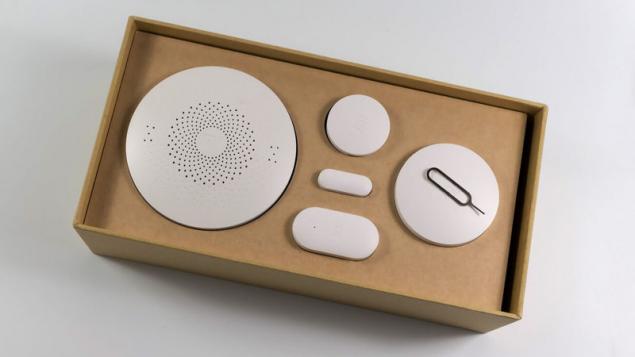
It looks like Xiaomi SmartHome Kit - a set of sensors and actuators, which in Russia is not for sale meet
. As for the Chinese Xiaomi, it was founded in 2010 and in a short time due to the consumption boom in China could become the third largest smartphone manufacturer in the world. In Xiaomi is a platform for smart home sensors for monitoring and opening windows, air cleaner, camera surveillance.
On the reverse side of the market "smart" household appliances heated startups seeking to have the greatest possible share of such a promising market. According IoT Analytics, the 2015 start-ups associated with "smart" appliances have received about $ 3 billion investment. Major rounds of investments received Quirky ($ 185 million USD), Prodea ($ 160 million), Alarm ($ 136 million), Savant ($ 90 million), SimpliSafe ($ 57 million).

Heatmap concentration hubs for technology development of "smart" house (bright color highlights the most advanced regions), IoT Analytics, 2016.
The most rapidly developing "smart" market houses will take place where converge several factors: the development of the market of Internet services developed by the electronics industry, the presence of many companies that are willing to work together on technologies, standards and infrastructure end-to-end solutions for the IoT. The largest such hubs (presented in heat map above) are in the United States - New York, in Europe - London, Asia - Pyongyang, Shanghai and Hong Kong, and the Middle East - Indian Bangalore
. How do the "smart" home technology
Household appliances "smart" house in terms of its devices and operating principles are very different. The unifying element is perhaps the only equipment of special sensors and able to connect to the Internet, and it is these criteria are not mandatory. Often, a "smart" technology, following a marketing feasibility, include just the current generation of devices, which has a broader function than the previous. Not every such device has its own processor, ie, the "nerve center" for information processing. Some Soup, for example, energy-saving light bulbs, can be equipped with sensors only, the information from which is processed in a special application for smartphones: with it they can, for example, enable or disable
.
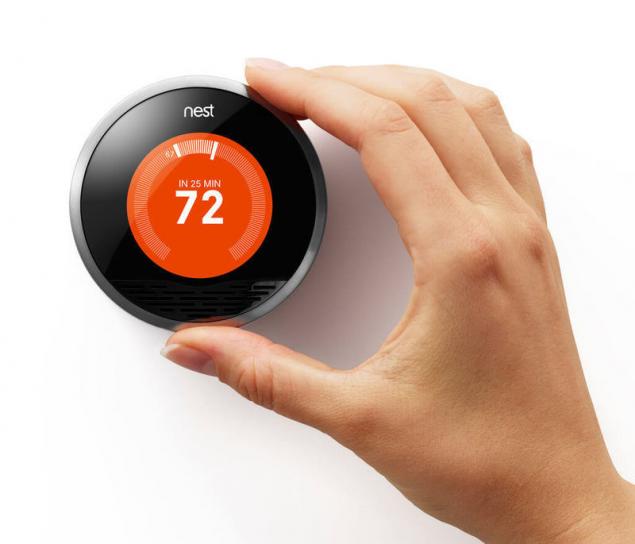
In fact, the Internet of things is already here. One of the most striking primerov- Nest thermostat. It collects data about how tenants heat or cool the room, and then begins to manage energy consumption in the home.
Also, most "smart" technology is an interactive interface to manage and involve a variety of mobile applications and web services. The control interface may consist of a few buttons or the touch screen, and is a huge monitor, like a new refrigerator Samsung in the example above. The most common internet connection is provided through a home hotspot Wi-Fi, but there can be variations, such as installing a special SIM-card for the IoT, or connect to the Ethernet cable.
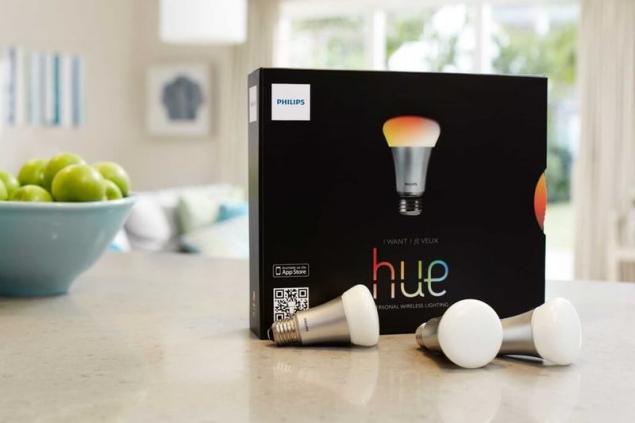
Another example - smart light bulbs Philips Hue. These LED lamps are able to change the color and tone of light and consume 80% less than incandescent lamp. And you can manage them using the app on iOS or Android.
There are quite exotic forms, such as smart key from the US Internet giant Amazon - Dash Button: gadget is designed as a branded button that is attached Velcro hook or in a convenient location. The button associated with the user account on Amazon, and you can quickly place an order for household goods, which tend to end up at the wrong time, whether it is of laundry detergent or toiletries.
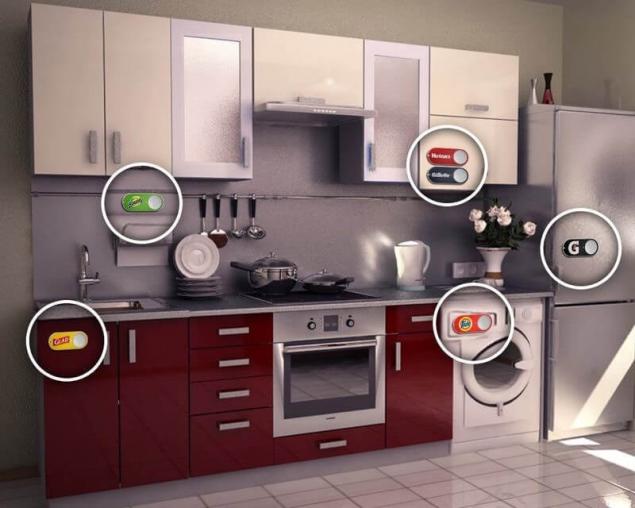
It may look set Amazon Dash button.
As of June 2016 the number of orders on Amazon using the Dash Button increased by 70%: the company added 50 new brands to the program. In total there are more than 150, including Energizer, L'Oreal Paris Revitalift, Peet's Coffee, Purina, Red Bul and Starbucks.
Russian specifics
What are the prospects for a "smart" home appliances market in Russia? Experts in agreement that it is only just emerging. So far, only one Russian producer of electronics - Redmond - made "smart" devices the basis of its product line. The "smart" line of Redmond is already more than a dozen devices. There is also a small kitchen appliances (kettle, multivarka, scales, coffee maker, Thermo), larger appliances for home (heater, air cleaner, fan, humidifier), irons, fitness scales and even some interesting things like smart sockets, sockets for lamps , smoke detectors. All of them can be controlled via the Internet using a utility for Ready for Sky smartphones.
Also, the media published information that in Togliatti technopark "Zhiguli valley" want to start a project to create "smart" refrigerators that will detect the content using neural networks, but so far it only plans.
"Global manufacturers offer expensive solutions that are not available to buyers with average incomes. According to our expectations, once manufacturers begin to develop this category and offer solutions in a more affordable price point, consumers will have the knowledge of higher sales to grow significantly. Who can estimate the market is not thousands, but hundreds of pieces "- told IoT.ru in the press service of the company«
M.Video ". Retailers say that intelligent machines in the Russian market are more represented in the category of gadgets for health and home automation space: Russians among the available brands - Netatmo, BeeWi, Mixberry. In the long term expected growth in demand for robotic vacuum cleaners with control via smartphone brands and leaders HOOVER Iboto. Also, customers are interested in air conditioning equipment with a mobile control: in "El Dorado" it will start selling in the fourth quarter of 2016. So the Russian house will "get smarter" with several late than London, New York and Shanghai.























